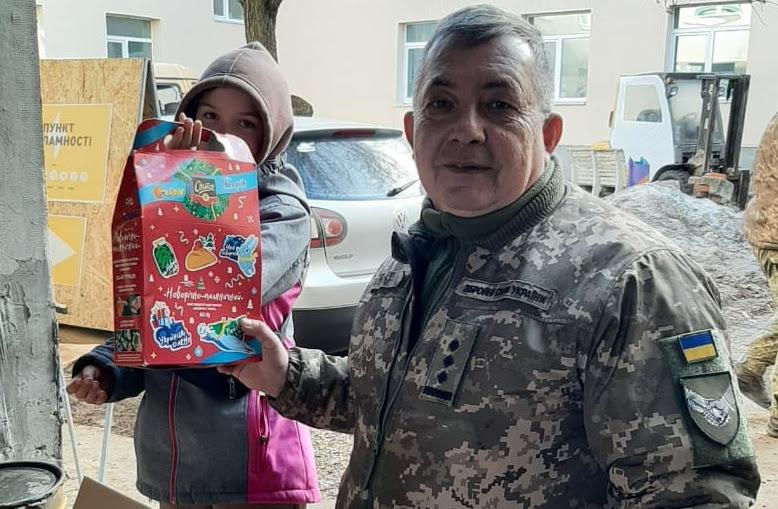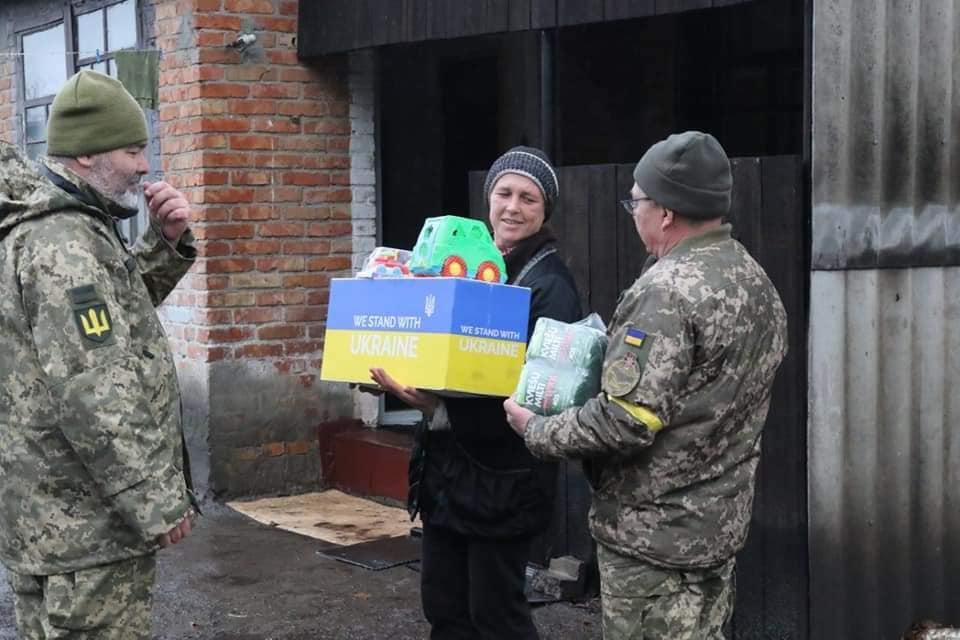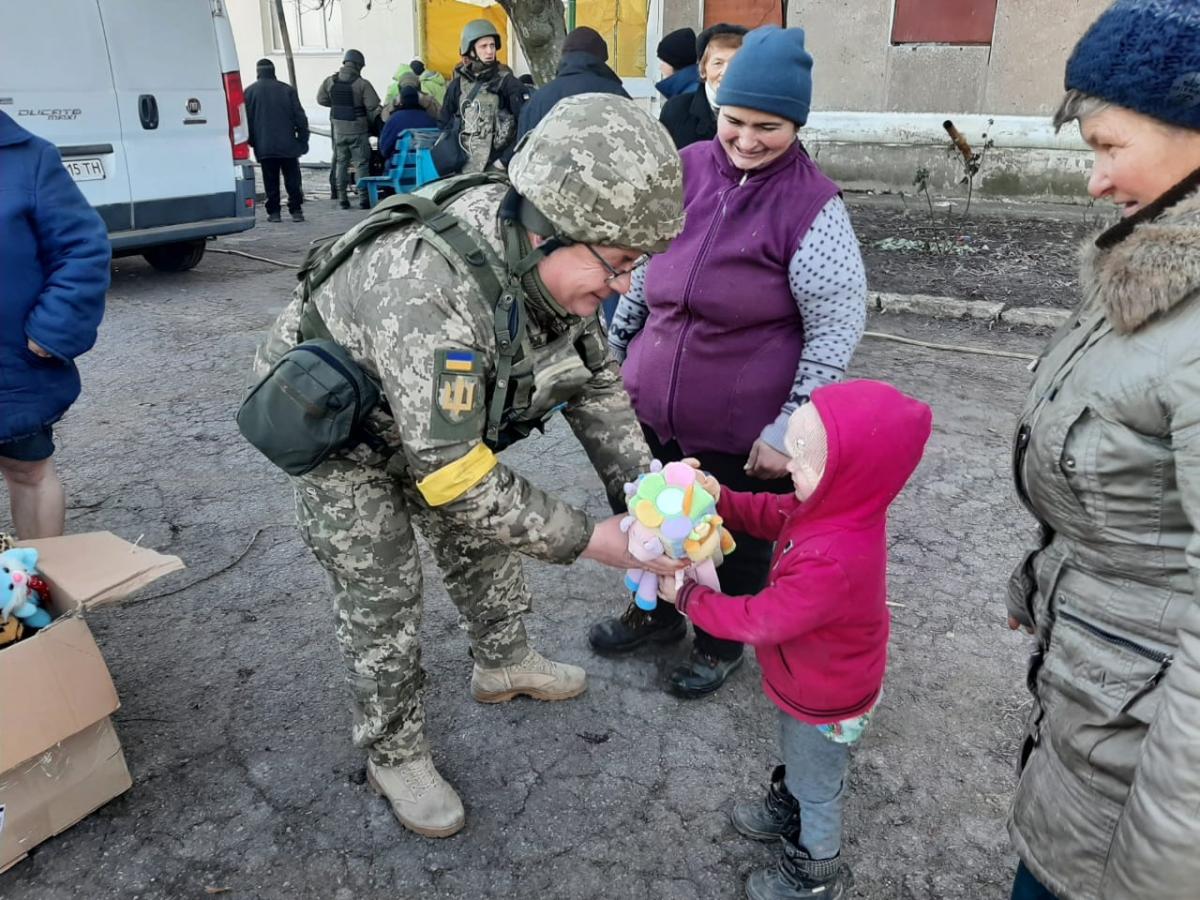The head of the civil-military cooperation group (CIMIC) of the operational-tactical group “Soledar”, Colonel Oleksandr Savenko, in an interview with , spoke about the humanitarian problems of the population in Bakhmut, Soledar, Chasovoy Yar, how the military helps these people, and are they ready to evacuate?
The structure of civil-military cooperation in the Armed Forces, formed according to NATO standards, exists in Ukraine since 2014 and better known by its abbreviation SIMIS (civil–militarycooperation). I know that the Sevens have been helping the residents of settlements on the demarcation line in Donbas for many years in solving humanitarian and everyday issues. To what extent have the directions of the military of this mission in Donetsk region changed now?
We continue to perform our functions. First, we are talking about interaction with local self-government bodies. For example, among our tasks is the restoration of infrastructure, in particular, demining (we carry out such measures whenever possible, but not in such volumes as during anti-terrorist operations/OOS).We recently received an appeal from the head of the military administration of Chasovoy Yar that there is a need to carry out demining on January 10. Therefore, sappers of one of the brigades are now helping to neutralize dangerous objects left by the occupiers. We are talking, in particular, about unexploded ammunition with which the Russians fired.
Another function now is the evacuation of fallen military personnel to the “On the Shield” burial sites.
We also cooperate with volunteer, public, and international organizations. For example, we cooperate with “Doctors Without Borders”, which provides assistance directly in city hospitals, “Red Cross”, which delivers the medical boxes and generators needed by doctors to hospitals.
Do such organizations deliver aid to the cities of Donetsk region, which are located literally on the front line?
I can tell you how lucky we are that humanitarian convoys are formed under the auspices of the UN by my former colleague and officer of the military-civilian cooperation mission. He clearly goes around populated areas and knows the requests of local residents. We, in turn, taking into account the security component, accompany him. For example, ten days ago they accompanied a large convoy, which included seven trucks weighing up to 10 tons. Thus, we delivered about 60 tons of various humanitarian aid, including warm blankets, food, water, hygiene products, etc. for the community of Chasovoy Yar (located 15 kilometers from Bakhmut and 30 kilometers from Soledar, – ).
What is the current situation on this front?
The situation in our area of responsibility is quite difficult. Literally all the big cities – Toretsk, Chasiv Yar, Bakhmut, Soledar – are on the lips of all of Ukraine.
In the Bakhmut direction, the Russians failed to implement their offensive. But, advancing on Soledar, they repeat the same scenario. That is, they continue to litter our cities with the corpses of their soldiers. They go to the slaughter, as in the Second World War: the value of human life for the Russians is nothing.
Our boys in Soledar are having a hard time at the moment, but they are holding on. The situation changes every day, that is, today, when we are talking, it can be one, and tomorrow – another.
Will it be possible to repel the invaders from this part of the front?
As the commander of the Ground Forces Oleksandr Syrsky reported, reinforcements are coming, and we are able to defend the city. But how quickly it will be possible to repulse the Russian advance on Soledar is unknown. Remember Bakhmut, who has been defending himself for more than six months. It’s not easy there now either, there are ongoing battles. Maybe not so intense, but the shelling continues there constantly. Nevertheless, we hope that the situation will be localized.
Can we say that the intensity of shelling of Bakhmut has decreased because the Russians are already exhausted?
To some extent, of course, we exhausted them. It is also possible that they started having problems with the availability of ammunition: with shells for the Grad anti-aircraft missile system, for artillery systems (it is not for nothing that they take them from warehouses in Belarus). After all, the density of their artillery fire is now much less.
And to some extent, I think, the Russians will feel the places of our defense in this direction. Maybe they have a rotation going on somewhere. That is, you should not underestimate the opponent.

Indeed, the quality of training of Russian mobilized is currently very low. And it affects the ability of the personnel to use this or that weapon. That is why we see that the artillery of the Russian Federation, to a greater extent, hits “in the wrong place”. They don’t shoot well, but believe me, they are unfortunately learning. The instinct of self-preservation comes into play here: if you want to live, you will learn to do everything to survive. Therefore, their shots also reach the targets.
Satellite images of Bakhmut bombed by the Russians, photos of dilapidated houses in Soledar have already circulated on the Internet. In your opinion, the occupiers deliberately ransack residential buildings and completely destroy the entire infrastructure of cities?
We must understand that they do not have high-precision weapons. They fire with outdated weapons that were developed back in the 50s and 60s. At the same time, they don’t care where to shoot. They do not pay attention to the difference of 300-400 meters.
In July, 48 people died simultaneously in one of the destroyed buildings during a rocket attack on Chasovoy Yar. The military was told that it was the most difficult evacuation of the victims. Do the people who get rid of these cities even have any opportunity to bury their loved ones?
I was not in that direction at the time. And in general, it is not always possible to bury a person when intense fighting is going on nearby.

I can give a personal example. My 14-year-old nephew died during hostilities in the Novaya Husarivka area of Kharkiv region. He was buried in a garden near the house. The opportunity to rebury him came only three weeks after the end of hostilities, when the settlement was liberated.
You saw photos from Lysychansk, from Mariupol, where people were literally buried near the entrances of high-rise buildings. I think the situation will be similar here.
Are there accurate data on the population remaining in settlements in your direction? Do you know how to find people in a half-ruined city?
Thus, the heads of the military administrations of Soledar, Toretsk and Chasovoy Yar clearly know how many people live in these communities, in which houses and in which basements. Therefore, we clearly know where to go for help, to whom to give it.
In general, up to three thousand Ukrainian citizens currently live in the most dangerous cities. According to official data, at the end of 2022, about 1,100 people remained in Bakhmut, of which 216 were children. Only about 600 residents remain in Soledar, including about a hundred children.
Many more people live in Kostyantynivka and Druzhkivka. In the city of Toretsk, for example, 16,500 residents remain, of which almost a thousand are children. But the situation in this city is definitely different from the places of fierce battles.
And how can the military help the population in such places?
After shelling, we can deliver film to local residents to repair windows. For example, we recently transferred such a film to Chasovoy Yar. Film and lights were also prepared for Soledar, but today we simply cannot get there due to compound security.
At the end of December, we managed to provide New Year’s gifts to children from virtually all local communities – Soledar, Chasovoy Yar, Toretsk, Bakhmut.
You have already mentioned children in these settlements twice. In what conditions do families with children live in cities where fierce fighting continues?
They hide near the basements, which are divided into small “rooms” by means of screens. One family lives in one part of the basement, another in the other, and the third “room” can store necessary things.
Almost every city has problems with light. The heads of the military administrations delivered generators and boilers to these communities in order to create some conditions for life. However, these conditions are not for children. Everyone knows how cold it is in winter. Banal: where to wash children? Nowhere. Is it possible to wash the child with water brought by volunteers.
We try to explain to parents that this is irresponsible. That it exposes the lives of their children to danger, because these are places of active hostilities. But they fundamentally do not want to leave. They have their own corner and don’t want to leave it.
Have you been approached at all by people who would like to evacuate?
Not to us. But our group has been working in this direction for only a month. During this hour, our officers helped to evacuate locals from one of the villages near Chasovoy Yar only once, on Sunday, January 8.
However, the heads of military administrations are actively engaged in evacuation. Their employees go around every apartment and basement regarding the issue of departure. And the “White Angel” (evacuation group of the National Police of Ukraine, — ) helps to take people out of the combat zone.
Most of those willing to leave already left in the summer and autumn. In winter, such cases are fewer and fewer. At the same time, the majority of those who evacuated are the pro-Ukrainian population. And among those who remained, unfortunately, there are the same “Zhduns” who were waiting for the “Russian world” in Lysychansk and Severodonetsk.

As the experience of the de-occupied Kherson region shows, without electricity and in a complete information blockade, people simply do not know what is happening “outside”, in the “big world”. I mean, they can be completely disorganized. Is it somehow possible to arrange information for people who are hiding from shelling in basements?
Currently, a project to launch Radio FM is already being implemented in one of the cities. The possible coverage range is up to 700 kilometers. This will be a radio wave that any radio receiver or radio application can tune to. We will also distribute newspapers to people (about three thousand copies have been ordered). Mobile communication can also be restored in a very short time: as soon as we move forward, as soon as there is the first opportunity, there will be electricity supply – the Internet and mobile communication will work very quickly.
Anastasia Svitlevska
Anastasia Svitlevska





